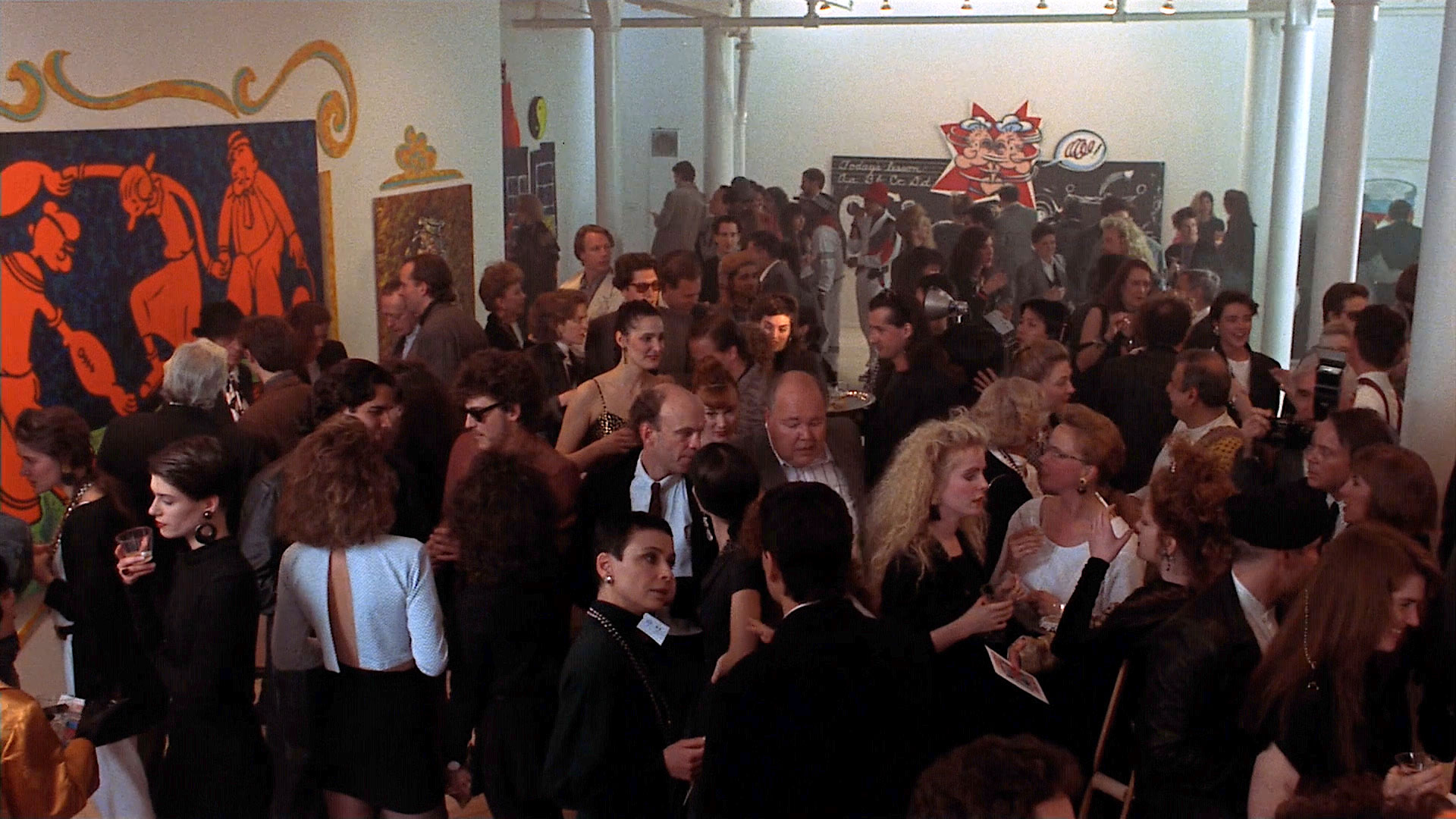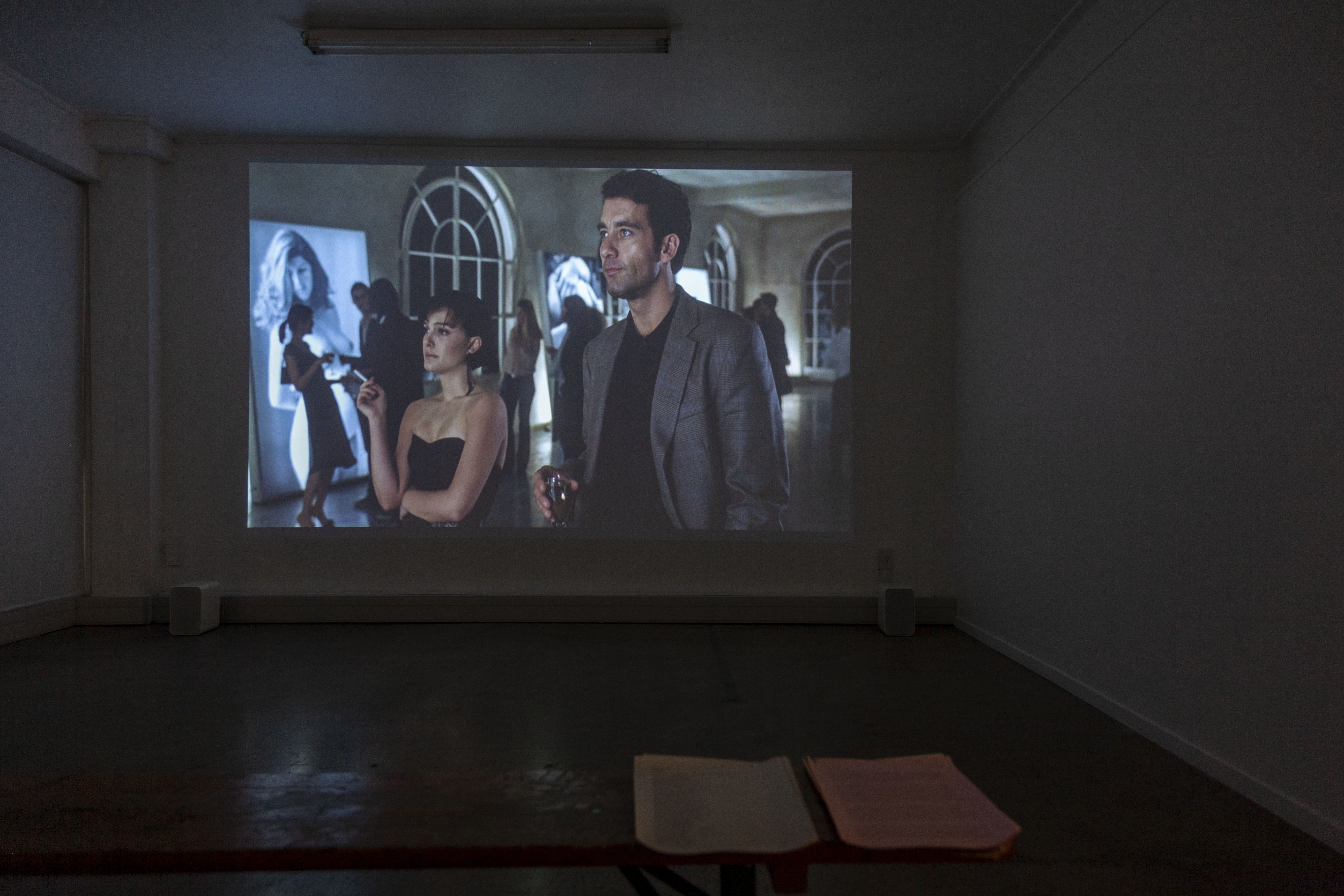
Openings
Exhibition by Daniel Strang
Openings | Daniel Strang | RM, Tāmaki Makaurau
15.06.22 | written by Theo Macdonald
Editor’s note: This essay was written by Theo Macdonald in March in response to Openings by Daniel Strang exhibited at RM. Due to other commitments, Vernacular was unable to publish it at the time. After reading the review by Eleanor Woodhouse published in The Art Paper Issue 02, we felt it necessary to revisit Theo’s response. So, in the spirit of critical public debate, Vernacular presents this alternative reading of Openings.

The centrepiece of Daniel Strang’s exhibition Openings at RM Gallery & Project Space is the titular video work. In YouTube vernacular, this video is a supercut of gallery openings appropriated from popular film, arranged chronologically from Scarlet Street (Fritz Lang, 1945) through The Artists Wife (Tom Dolby, 2020). Notable stops along the way include Vincent & Theo (Robert Altman, 1990), La Haine (Mathieu Kassovitz, 1995), and Basquiat (Julian Schnabel, 1996). It is four hours long and projected large against the wall of the darkened gallery. A photographic work, Grin without a cat, accompanies the video and similarly appropriates frames of the Cheshire Cat from three disparate adaptations of Lewis Carroll’s Alice in Wonderland.
The centrepiece of Daniel Strang’s exhibition Openings at RM Gallery & Project Space is the titular video work. In YouTube vernacular, this video is a supercut of gallery openings appropriated from popular film, arranged chronologically from Scarlet Street (Fritz Lang, 1945) through The Artists Wife (Tom Dolby, 2020). Notable stops along the way include Vincent & Theo (Robert Altman, 1990), La Haine (Mathieu Kassovitz, 1995), and Basquiat (Julian Schnabel, 1996). It is four hours long and projected large against the wall of the darkened gallery. A photographic work, Grin without a cat, accompanies the video and similarly appropriates frames of the Cheshire Cat from three disparate adaptations of Lewis Carroll’s Alice in Wonderland.
 Daniel Strang, Openings, 2022. Installed at RM. Photo by Majlinda Hoxha.
Daniel Strang, Openings, 2022. Installed at RM. Photo by Majlinda Hoxha.The provenance of Strang’s project is easily recognised. Grin without a cat follows the model of Richard Prince’s 1970s collages like Untitled (three women with their heads cast down), neatly stolen film stills linked by composition or content. The video adopts the method of Christian Marclay’s The Clock (2010), a highly ambitious twenty-four-hour video that appropriates existing film material to produce a functional clock. An additional touchstone gleaned from reading the accompanying text is the art critic and curator Nicolas Bourriaud’s 2002 essay Postproduction: Culture as Screenplay: How Art Reprograms the World. In this essay, Bourriaud uses a DJ analogy to describe how artists such as Pierre Huyghe interpolate pre-existing cultural objects through their conceptual practices. Bourriaud cites many artists that share Strang’s gluttonous approach to cinematic material.
When translated into a gallery context, the supercut method appeals to one of two impulses. The first, expressed in Marclay’s clock, is the spectacle. With substantial institutional support, Marclay took three years to locate and assemble the footage to fill out his project. The real possibility of failure within the project makes the completion more impressive. Dick Whyte’s Pulp Fan Fiction (2013) is a local example of spectacular cinephilia. Whyte trawled YouTube for fan reenactments of scenes from Quentin Tarantino’s Pulp Fiction (1994) and successfully re-assembled a complete remake of the original film.
When translated into a gallery context, the supercut method appeals to one of two impulses. The first, expressed in Marclay’s clock, is the spectacle. With substantial institutional support, Marclay took three years to locate and assemble the footage to fill out his project. The real possibility of failure within the project makes the completion more impressive. Dick Whyte’s Pulp Fan Fiction (2013) is a local example of spectacular cinephilia. Whyte trawled YouTube for fan reenactments of scenes from Quentin Tarantino’s Pulp Fiction (1994) and successfully re-assembled a complete remake of the original film.

Daniel Strang, Openings (still), 2022, 1080P HD video, colour & black and white, stereo, 4 hours. Courtesy of the artist.
The second application of supercut is toward overt criticism, either of or using mass media touchstones. Jane Chang Mi’s ゴジラ/ɡɒdˈzɪlə/ (2020) simultaneously layers all twenty-nine kaiju monster movies produced by Toho Company Limited. Chang Mi recognises the genre’s ongoing metaphor of nuclear imperialism and erases every image of humans and monsters from this material. What remains is an overwhelming parade of environmental destruction.
Strang’s Openings is oriented toward the former interpretation by his neoclassical emphasis on resolution and clarity. Every frame is crisp as can be. Per the accompanying statement, “Openings is an obsessive and meticulous compilation, an expression of archival cinephilia.” Strang means to impress, but the work falls short. Perhaps it could do with less cinephilia and more of a critical edge.
The context of Openings is conceptual video, and in the decade since Marclay and Whyte’s supercuts, the technical challenges of this form have changed. The website TV Tropes, which records cliché and motifs across popular media, is now massive, making many projects of this type largely redundant. Locating and pirating obscure cinema is also substantially easier now that streaming platforms have replaced terrestrial media. Furthermore, Strang’s project lacks ambition. It is missing Marclay and Whyte’s projects’ important capacity for failure.
Strang’s Openings is oriented toward the former interpretation by his neoclassical emphasis on resolution and clarity. Every frame is crisp as can be. Per the accompanying statement, “Openings is an obsessive and meticulous compilation, an expression of archival cinephilia.” Strang means to impress, but the work falls short. Perhaps it could do with less cinephilia and more of a critical edge.
The context of Openings is conceptual video, and in the decade since Marclay and Whyte’s supercuts, the technical challenges of this form have changed. The website TV Tropes, which records cliché and motifs across popular media, is now massive, making many projects of this type largely redundant. Locating and pirating obscure cinema is also substantially easier now that streaming platforms have replaced terrestrial media. Furthermore, Strang’s project lacks ambition. It is missing Marclay and Whyte’s projects’ important capacity for failure.
 Daniel Strang, Openings, 2022. Installed at RM. Photo by Majlinda Hoxha.
Daniel Strang, Openings, 2022. Installed at RM. Photo by Majlinda Hoxha.In stand-up comedy, an overused or unoriginal joke is termed “hack”. It is a feeling, not as objective as overt joke theft, and often carries the baggage of implied condescension. Openings feels hack. Any video artist with a foot in appropriation has jotted down an idea for a supercut. Most don’t pursue these ideas because it simply isn’t worth the time. They are the sort of artworks that are more fun to talk about than visit.
Some things are better left in the studio, and I wonder if Openings should have been (or perhaps could still be) the beginning of this project rather than the conclusion. The concept needs some twists to make it enjoyable. Visiting the exhibition at the opening, I wanted the sense that Strang was somehow processing this material. Why arrange this material chronologically? Why not by genre? By shot type? Something to break down the language of this perennial set piece.
There is a deep first-thought-best-thought arbitrariness to Strang’s material. Why openings and not gallery visits? Why not parallel the gallery visit scenes from Guess Who’s Coming to Dinner (1967) and Beverly Hills Cop (1984)? In both films, the Black lead’s discomfort in the white cube allegorises the actor’s move from the multiracial world of East Coast theatre to the white hostility of Hollywood film studios. After Claire Harris’s performance series Happy Birthday, Lindsay Lohan (2011-2014), why not watch every film in its entirety within the gallery space?
The point is, there are options Strang could have taken. Instead, we are left with this teleological research dump, limp at the foot of the cinema door. Perhaps here we find that sense of failure.
Some things are better left in the studio, and I wonder if Openings should have been (or perhaps could still be) the beginning of this project rather than the conclusion. The concept needs some twists to make it enjoyable. Visiting the exhibition at the opening, I wanted the sense that Strang was somehow processing this material. Why arrange this material chronologically? Why not by genre? By shot type? Something to break down the language of this perennial set piece.
There is a deep first-thought-best-thought arbitrariness to Strang’s material. Why openings and not gallery visits? Why not parallel the gallery visit scenes from Guess Who’s Coming to Dinner (1967) and Beverly Hills Cop (1984)? In both films, the Black lead’s discomfort in the white cube allegorises the actor’s move from the multiracial world of East Coast theatre to the white hostility of Hollywood film studios. After Claire Harris’s performance series Happy Birthday, Lindsay Lohan (2011-2014), why not watch every film in its entirety within the gallery space?
The point is, there are options Strang could have taken. Instead, we are left with this teleological research dump, limp at the foot of the cinema door. Perhaps here we find that sense of failure.
 Daniel Strang, Openings (still), 2022, 1080P HD video, colour & black and white, stereo, 4 hours. Courtesy of the artist.
Daniel Strang, Openings (still), 2022, 1080P HD video, colour & black and white, stereo, 4 hours. Courtesy of the artist.Openings by Daniel Strang, 16th February – 12th March 2022 at RM Gallery and Project Space, Tāmaki Makaurau.
Thanks to The Art Paper for making Eleanor Woodhouse’s review of Openings free to access online. Buy a copy of The Art Paper 02 here.
Article image: Daniel Strang, Openings (still), 2022, 1080P HD video, colour & black and white, stereo, 4 hours. Courtesy of the artist.
Thanks to The Art Paper for making Eleanor Woodhouse’s review of Openings free to access online. Buy a copy of The Art Paper 02 here.
Article image: Daniel Strang, Openings (still), 2022, 1080P HD video, colour & black and white, stereo, 4 hours. Courtesy of the artist.
ISSN 2744-7952
Thank you for reading ︎
Vernacular logo designed by Yujin Shin
vernacular.criticism ︎

